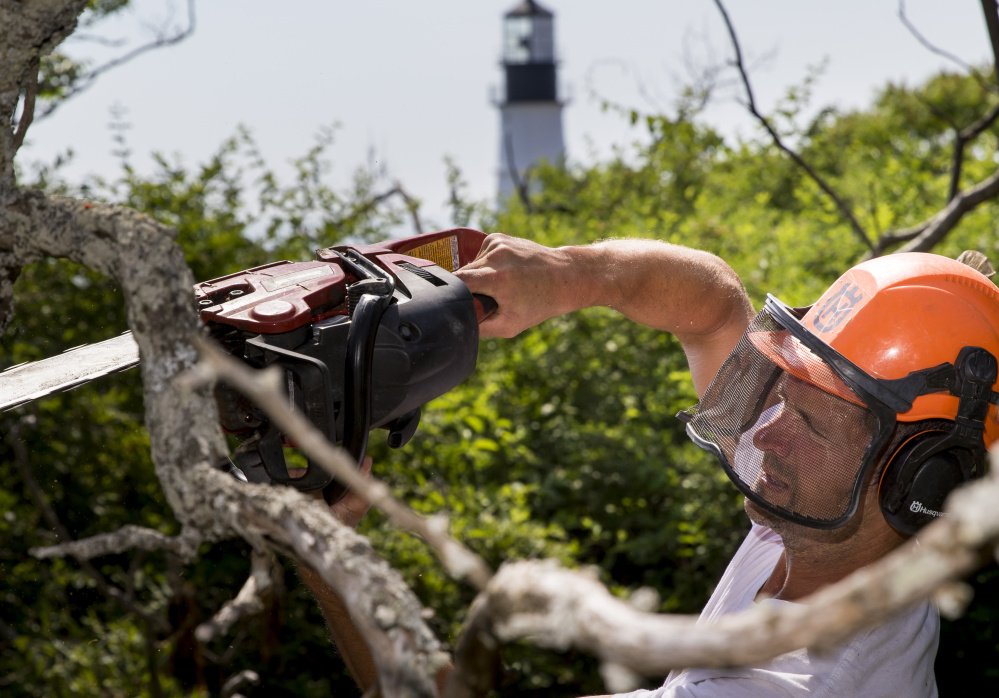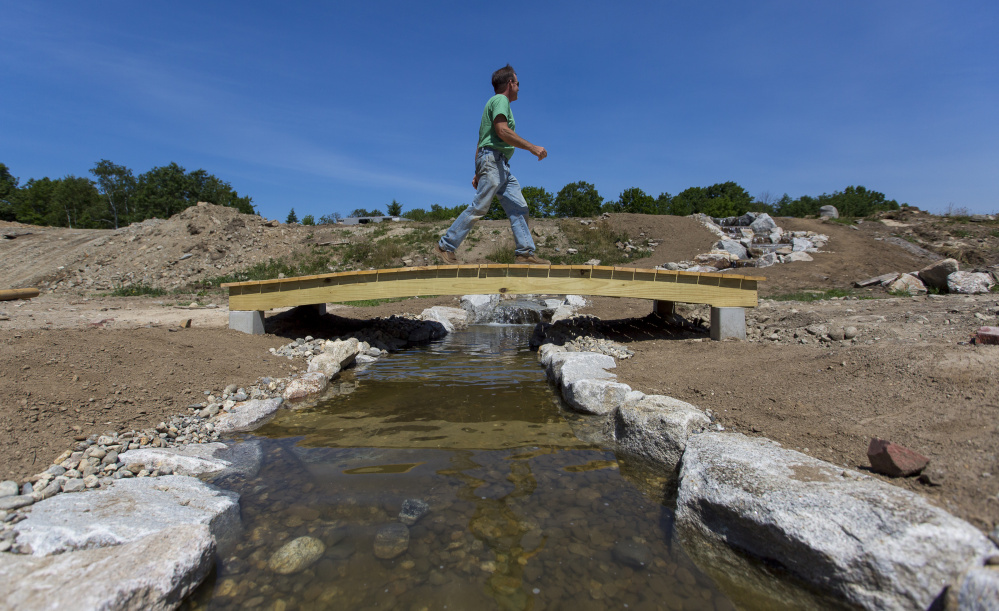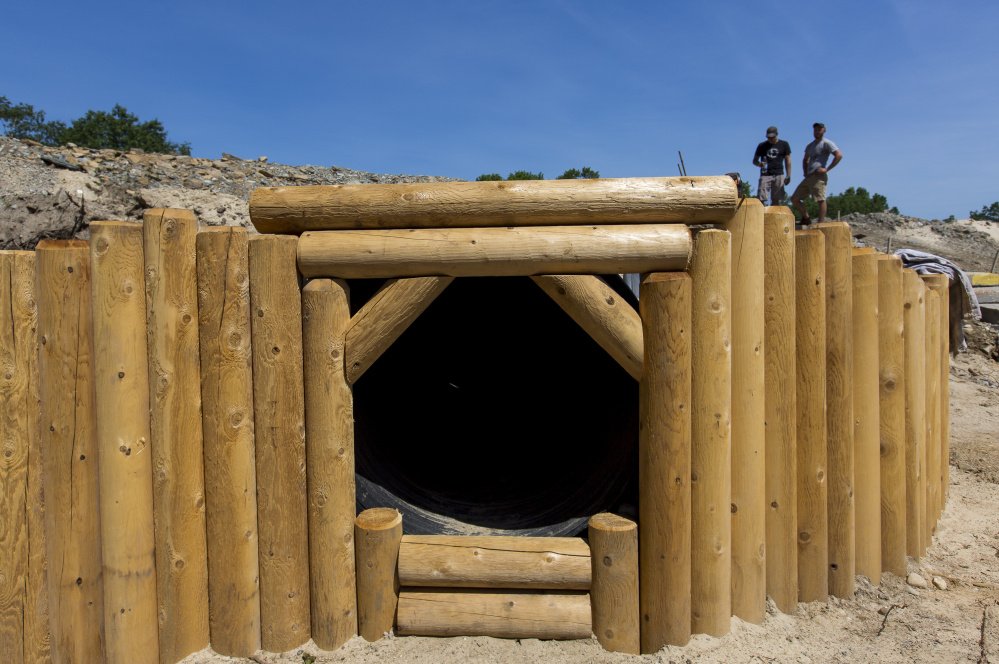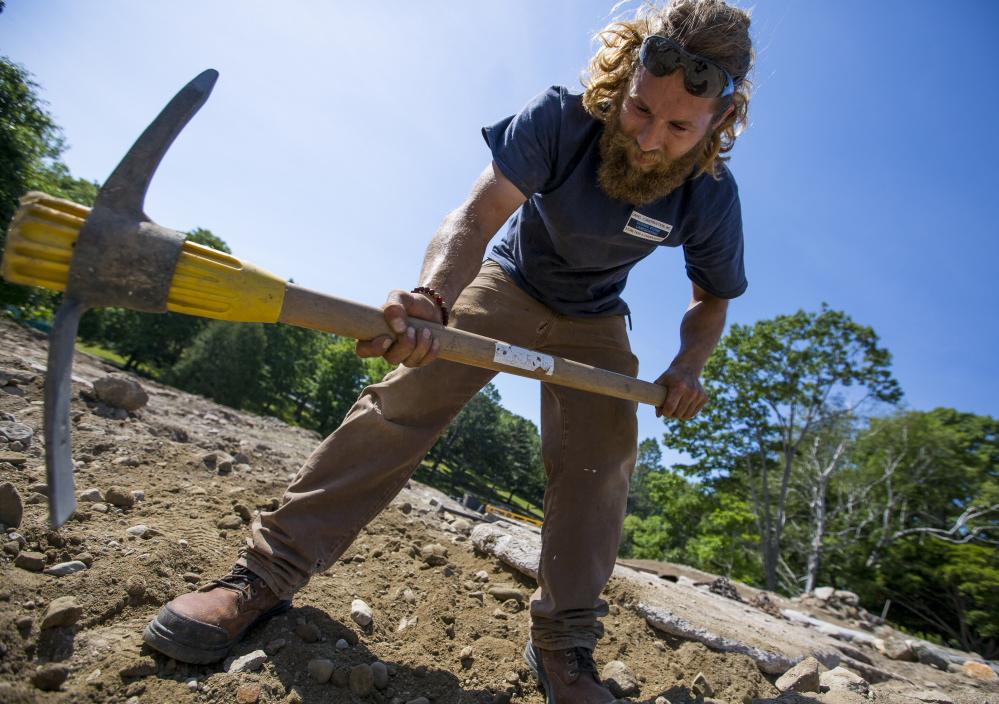CAPE ELIZABETH — A rocky stream cascades from a newly created frog pond, down a hillside that once offered little but parched lawn and invasive weeds.
Nearby, a natural meadow is being planted, hinting at the wide variety of native wildflowers and grasses that will grow there in the future.
The Children’s Garden is under construction at Fort Williams Park, one of Maine’s most popular recreational areas – a town park that draws nearly 1 million people annually from around the world to see Portland Head Light, Casco Bay and other attractions.
Despite its name, the $400,000 landscaping project by the Fort Williams Park Foundation is transforming 1.5 acres of the 90-acre park into a natural wonderland that’s apt to impress adults as much as children.
“The child in all of us is going to enjoy this place,” said James McCain, arboretum director of the park. “It will beckon you to explore all the wonders along the way.”
The garden is expected to be completed by early August and welcome the public for a grand opening celebration at 4:30 p.m. on Sept. 9.
The project was designed by Sashie Misner of Mitchell & Associates Landscape Architects of Portland. The design was selected through a competition held in 2012.
The garden had strong community support from the start. The nonprofit foundation raised $390,294 to fund the project, including $82,685 from individuals and families; $135,950 from the sale of engraved paving stones, mostly from individuals and families; $26,445 from businesses and organizations; and $27,713 from fundraising events. An additional $117,500 in grants came from the Phineas Sprague Memorial Foundation, Morton-Kelly Charitable Trust, Lennox Foundation, Coulombe Family Foundation, TD Charitable Foundation and Unum.
“Everyone loves the Fort,” said Cape native Andie Mahoney, a foundation board member who visited the park regularly as a kid and now brings her five children there.
“It’s such an incredible place and a resource for people of all ages,” Mahoney said. “But the neat thing about the Children’s Garden is that it’s going to get more kids out to the Fort and into nature for entire afternoons.”

AN INLAND OASIS
Established as a military installation in the 1800s, Fort Williams was decommissioned in 1963 and purchased by the town in 1964 for $200,000.
While most of the park is oriented toward the waterfront, the garden will be an inland oasis of sorts, located on the right side of Ocean Road as visitors drive in from the main entrance on Shore Road. The area is readily accessed from the first parking lot on the right, down beyond the parade ground, bleachers and ball field.
“Right now, the park is very focused on the waterfront,” McCain said. “I expect the Children’s Garden to be a real draw for people and become the heart of the park.”
A central, handicap-accessible path crosses the garden, so people in wheelchairs and parents with strollers will be able to visit an area of the park that previously was inaccessible and inhospitable.
A major feature of the garden is the Council Ring, a stone-and-concrete bandstand built during the Great Depression by the Civilian Conservation Corps. Set among several mature oak trees, the shaded platform has been refurbished with fresh bricks and engraved granite paving stones.
Touched by dappled sunlight, the Council Ring will provide a cool gathering space on hot summer days for recreation programs, nursery school groups and library reading hours, furthering the arboretum’s goal to enhance educational opportunities in the park.
The Children’s Garden will help fulfill several of the arboretum’s overall goals, which include reversing damage done by invasive plant species and restoring native biodiversity and wildlife habitat, McCain said.
In recent weeks, workers have removed yards of black swallow wort, a vine-like member of the milkweed family that originated in Europe and literally chokes out native species here.
Found throughout the park, the plant also harms monarch butterflies, which thrive on native milkweed varieties. Unfortunately, when monarchs lay eggs on black swallow wort, the hatched larvae die when they feed on the plant, McCain said.
The bulk of work on the garden is being done by L.P. Murray & Sons of Cape Elizabeth and Linkel Construction of Topsham.
The Children’s Garden will include a tiered woodland area complete with a fairy village, a “gopher tunnel” that kids can skitter through, and a tree fort lookout built by Three Stone Landscape of Portland. The woodland will feature several trees that have been growing in the park for decades, including a rare sprawling white ash, a red maple, a Japanese yew and a clump of fat-trunked birches.
NATURE UP CLOSE
Robin’s Nest of Hollis created the frog pond and cascading stream, which are fed by water from an existing spring-fed skating pond near the Farnsworth Road entrance to the park.
Water is pumped from the skating pond, up to the frog pond, which is designed to be a natural bio-filter for the water. Then it flows into the stream, down the hillside under two foot bridges, and back to the skating pond.
The frog pond will be planted with native aquatic flowers and vegetation, and it will be bisected by a path of strategically placed steppingstones.
“That way kids can walk through the pond and get right up close to it,” McCain said.
Mahoney imagines her kids and other children playing in the shallow stream, which already fills the developing garden with the soothing sound of rushing water.
“There’s hours and hours to be had, crossing over those bridges, floating sticks in the water and wading in that stream,” she said.
In time, the frog pond’s bio-filter system and the stream are expected to aerate and clarify the murky skating pond, which is targeted for future landscaping improvements, McCain said.
Because of obvious risks related to the water features and other aspects of the garden, signs will be posted advising that children should be accompanied by adults, and children’s groups will be required to have adult supervision, McCain said.
Beyond the frog pond, the natural meadow will be laced with mulched and mowed paths, encouraging children to roam among fields planted with purple coneflower, blue wild indigo, black-eyed Susan, spotted bee balm and switchgrass.
“Once the plants have matured, it will be a lot of fun for kids to wander through,” McCain said.
Most of the plants will be grown from seed, so McCain hopes local gardeners will donate desired native species that may be growing in their own yards. A wish list is posted on the project’s webpage.
“There are some things we could use en masse because we have so much space to fill,” McCain said.
To donate plants or to make a financial contribution to the garden project, visit the foundation’s website at www.fortwilliams.org or call 767-3707.
Send questions/comments to the editors.






Comments are no longer available on this story